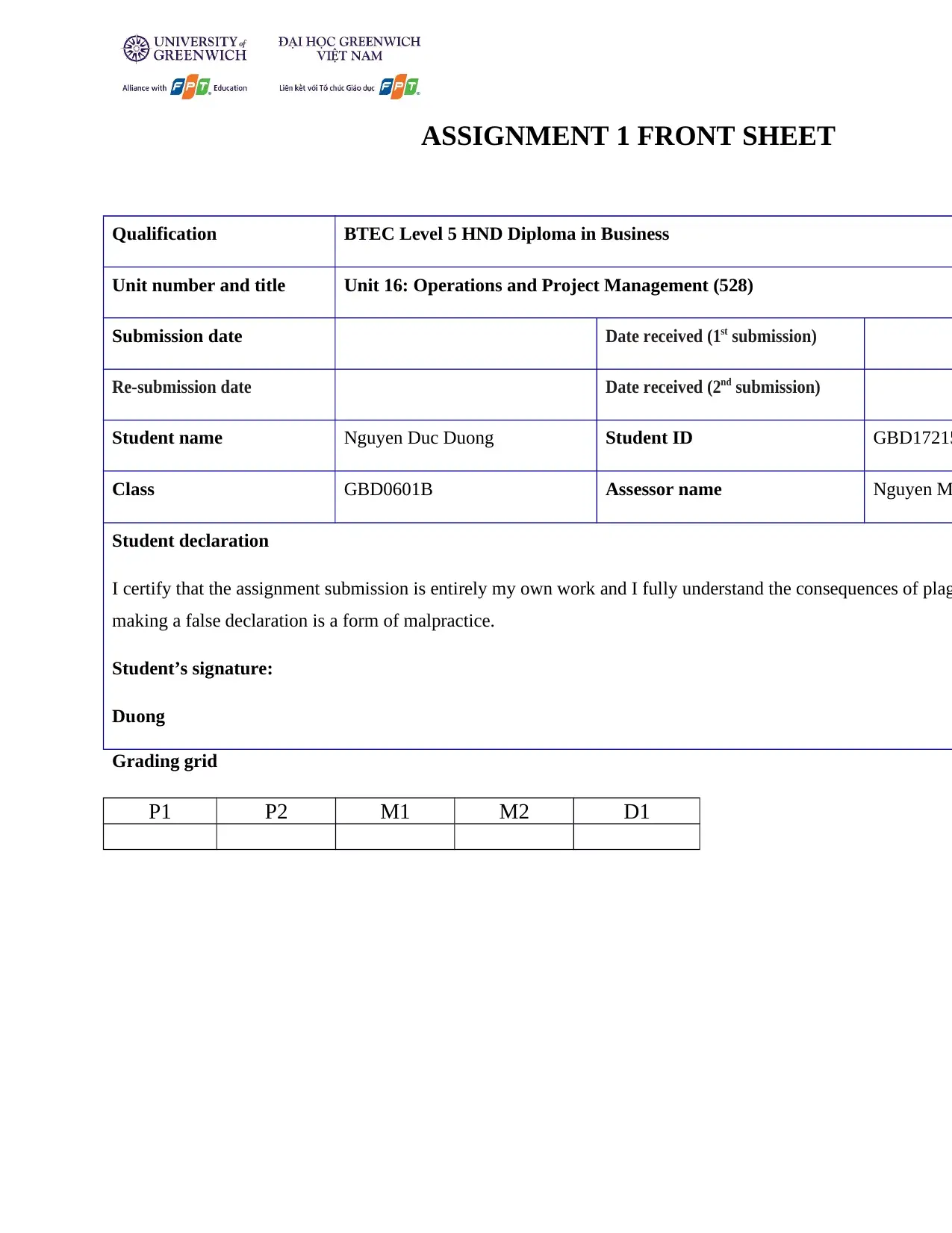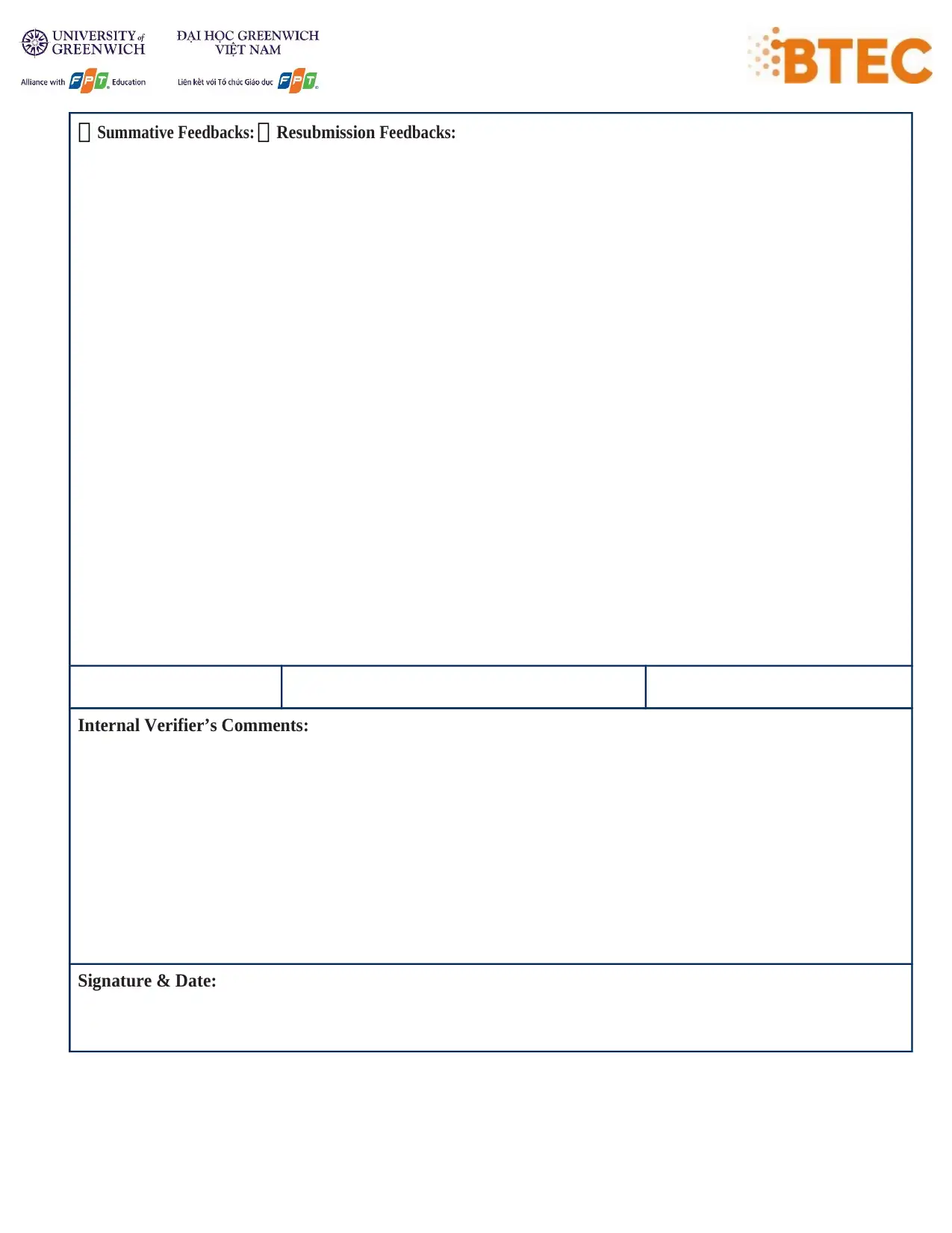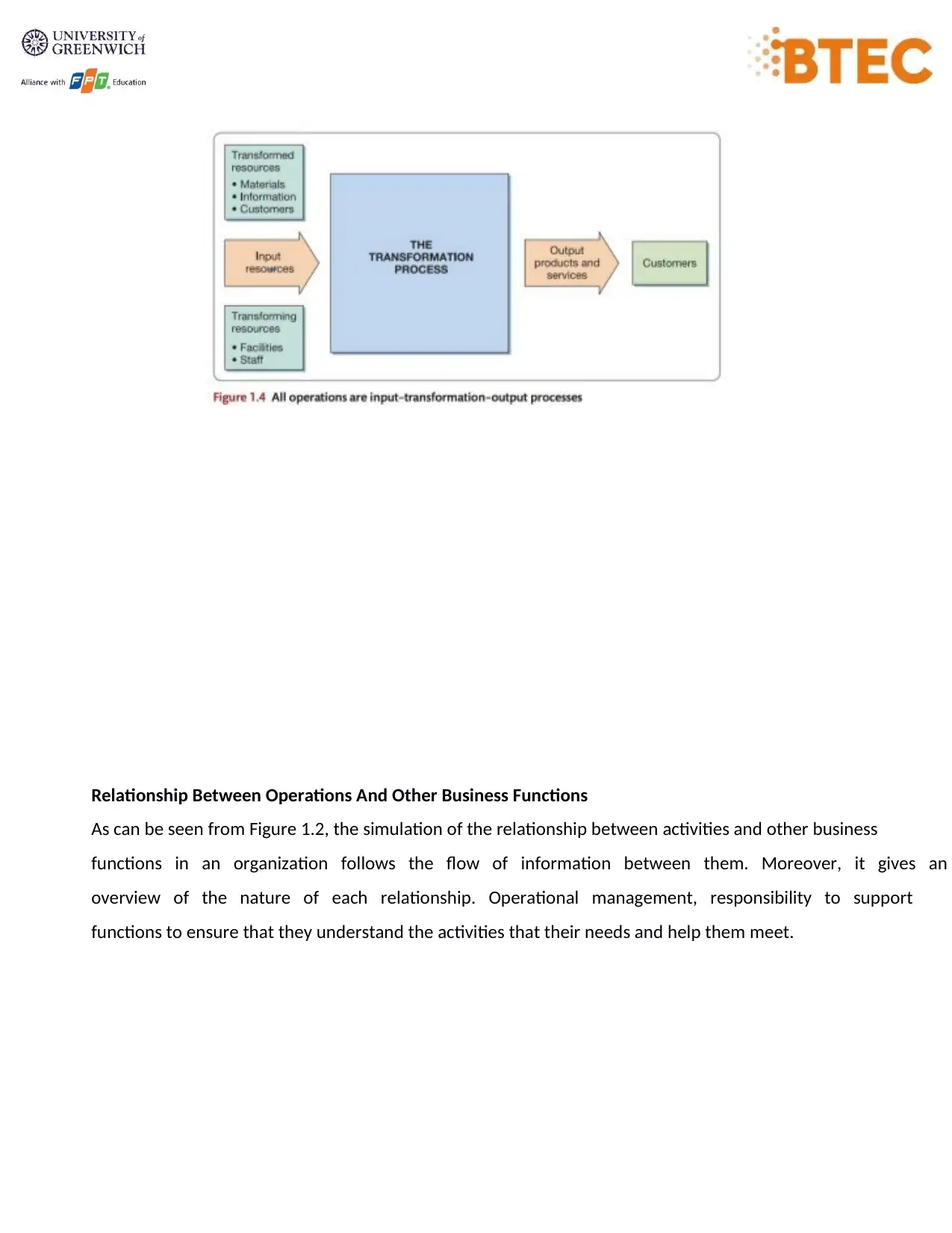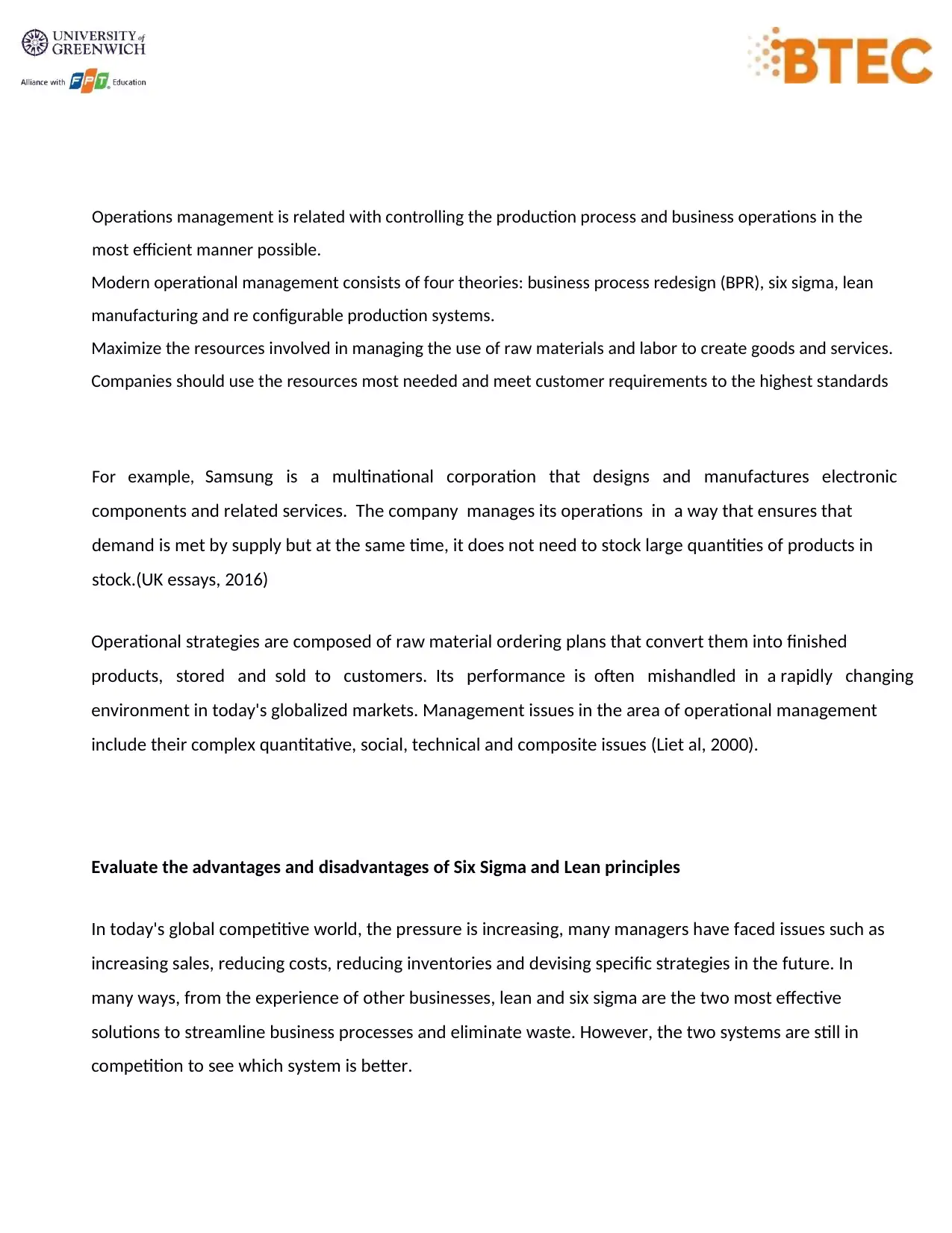BTEC Level 5 HND Unit 16: Operations and Project Management Report
VerifiedAdded on 2022/04/09
|24
|5215
|30
Report
AI Summary
This report provides a comprehensive analysis of operations and project management principles, using Samsung as a case study. It begins with an introduction to key concepts, including the input-transformation-output process and the relationship between operations and other business functions. The report then reviews and critiques the implementation of operations management processes within an organizational context, focusing on Samsung's operational strategies. It evaluates the advantages and disadvantages of Six Sigma and Lean principles, comparing their applications in business management. The report concludes with a continuous improvement plan based on the review of operations management principles for Samsung and provides recommendations to achieve improved efficiency. The assignment is a detailed exploration of operational strategies and their impact on business performance.

ASSIGNMENT 1 FRONT SHEET
Qualification BTEC Level 5 HND Diploma in Business
Unit number and title Unit 16: Operations and Project Management (528)
Submission date Date received (1st submission)
Re-submission date Date received (2nd submission)
Student name Nguyen Duc Duong Student ID GBD17215
Class GBD0601B Assessor name Nguyen M
Student declaration
I certify that the assignment submission is entirely my own work and I fully understand the consequences of plag
making a false declaration is a form of malpractice.
Student’s signature:
Duong
Grading grid
P1 P2 M1 M2 D1
Qualification BTEC Level 5 HND Diploma in Business
Unit number and title Unit 16: Operations and Project Management (528)
Submission date Date received (1st submission)
Re-submission date Date received (2nd submission)
Student name Nguyen Duc Duong Student ID GBD17215
Class GBD0601B Assessor name Nguyen M
Student declaration
I certify that the assignment submission is entirely my own work and I fully understand the consequences of plag
making a false declaration is a form of malpractice.
Student’s signature:
Duong
Grading grid
P1 P2 M1 M2 D1
Paraphrase This Document
Need a fresh take? Get an instant paraphrase of this document with our AI Paraphraser

Summative Feedbacks: Resubmission Feedbacks:
Internal Verifier’s Comments:
Signature & Date:
Internal Verifier’s Comments:
Signature & Date:

⊘ This is a preview!⊘
Do you want full access?
Subscribe today to unlock all pages.

Trusted by 1+ million students worldwide

Table of content
1.Introduction……………………………………………………………………………………………………………………………………..4 II.
Conduct a review and critique of the key concepts of operations management……………………………...4
- Conduct a review & critique of the implementations of operations management processes within an
organizational context………………………………………………………………………………………………………………………...5
IV. Prepare a continuous improvement plan based on the review and critique of operations management
principles for the chosen company……………………………………………………………………………………………………...10
V. Recommendations to achieve improved efficiency………………………………………………………………………………………...11
VI. Conclusion……………………………………………………………………………………………………………………………………...12
Reference Lists……………………………………………………………………………………………………………………………………..13
1.Introduction……………………………………………………………………………………………………………………………………..4 II.
Conduct a review and critique of the key concepts of operations management……………………………...4
- Conduct a review & critique of the implementations of operations management processes within an
organizational context………………………………………………………………………………………………………………………...5
IV. Prepare a continuous improvement plan based on the review and critique of operations management
principles for the chosen company……………………………………………………………………………………………………...10
V. Recommendations to achieve improved efficiency………………………………………………………………………………………...11
VI. Conclusion……………………………………………………………………………………………………………………………………...12
Reference Lists……………………………………………………………………………………………………………………………………..13
Paraphrase This Document
Need a fresh take? Get an instant paraphrase of this document with our AI Paraphraser

I. Introduction
This assignment below will show about business theories that come to the company specifically chosen
as Samsung Company. Moreover, a review and criticism of the implementation of the operational
management principles in theory and Samsung, also creates a plan of continuous improvement based on
that. All of that comes with smaller details, theory and examples.
II. A review and critique of the implementation of operations management principles within
an organizational context.
1. Define the key concepts
According to (Slack.N et al., 2010, p4), operation can be understand is an activity in business which is
performance of change the inputs into output and input is something like resources, output is product
and services for the customer. “Operation Management is the activity of managing the resources which
produce and present products and services”. There is always an active function in every business,
because every organization produces some kind of product and service. Operational functions are part of
the organization responsible for the results of products and services.
All operations in an organization produce products and services by changing inputs into outputs using
‘input-transformation-output processes’. As shown in Figure 1.4 below, activities are processes that take
a set of input resources that are used to transform themselves into outputs of products and services. For
example, if you just take a quick look at a motorcycle manufacturing company and a technology software
company, then maybe they are the same in how they do it, but getting closer, the difference begins.
show that one is product production and the other is service production. The main difference between
the two activities is the nature of the input (Slack.N et al., 2019)
This assignment below will show about business theories that come to the company specifically chosen
as Samsung Company. Moreover, a review and criticism of the implementation of the operational
management principles in theory and Samsung, also creates a plan of continuous improvement based on
that. All of that comes with smaller details, theory and examples.
II. A review and critique of the implementation of operations management principles within
an organizational context.
1. Define the key concepts
According to (Slack.N et al., 2010, p4), operation can be understand is an activity in business which is
performance of change the inputs into output and input is something like resources, output is product
and services for the customer. “Operation Management is the activity of managing the resources which
produce and present products and services”. There is always an active function in every business,
because every organization produces some kind of product and service. Operational functions are part of
the organization responsible for the results of products and services.
All operations in an organization produce products and services by changing inputs into outputs using
‘input-transformation-output processes’. As shown in Figure 1.4 below, activities are processes that take
a set of input resources that are used to transform themselves into outputs of products and services. For
example, if you just take a quick look at a motorcycle manufacturing company and a technology software
company, then maybe they are the same in how they do it, but getting closer, the difference begins.
show that one is product production and the other is service production. The main difference between
the two activities is the nature of the input (Slack.N et al., 2019)

Relationship Between Operations And Other Business Functions
As can be seen from Figure 1.2, the simulation of the relationship between activities and other business
functions in an organization follows the flow of information between them. Moreover, it gives an
overview of the nature of each relationship. Operational management, responsibility to support
functions to ensure that they understand the activities that their needs and help them meet.
As can be seen from Figure 1.2, the simulation of the relationship between activities and other business
functions in an organization follows the flow of information between them. Moreover, it gives an
overview of the nature of each relationship. Operational management, responsibility to support
functions to ensure that they understand the activities that their needs and help them meet.
⊘ This is a preview!⊘
Do you want full access?
Subscribe today to unlock all pages.

Trusted by 1+ million students worldwide

The key responsibilities of an operations manager
Figure 2 shows the basic responsibilities that an operation manager needs to do, which makes it possible
to handle things more neatly and properly.
Figure 2 shows the basic responsibilities that an operation manager needs to do, which makes it possible
to handle things more neatly and properly.
Paraphrase This Document
Need a fresh take? Get an instant paraphrase of this document with our AI Paraphraser

• Directing the overall and strategy of the operation, understanding of their operations and processes,
and their strategic and performance goals.
• Designing the operation’s services, products and processes
• Planning and control process delivery. Thereafter, the provision of services and products from
suppliers and through all activities to customers must be planned and controlled.
• Developing process performance. They are responsible for developing the ability of their processes to
improve process performance.
If we want to run a small business, we may need to hire an operational manager. This expert oversees
important aspects of the company such as production, human resources and inter-departmental
communications, and is also responsible for maintaining quality control standards and ensuring that the team
meets milestones. time and production time. The operations manager also ensures that the various parts of
the business are working smoothly toward the desired goal. It is essential to understand the full
responsibilities of the operations manager, before you want to hire someone to take up the position.
(Sampson Quain, 2019)
They are responsible for the overall operation of the company, managers who tend to have a big
perspective. They can also identify needs within the company and connect teams to solve problems as
they arise. They need to be commentators, critics, who can analyze situations and make decisions that
are in the best interest of the company rather than a department. Further may mean they also need to
resolve conflicts as they arise between employees and establish policies and guidelines on how to
accomplish the task.
In terms of skills and abilities, operational managers need a combination of hard and soft skills.
Depending on the industry, managers may need talent and mechanical knowledge of production
equipment, and will use computers and many related software programs, including guest management
tools, sales and budgeting and accounting.
-
and their strategic and performance goals.
• Designing the operation’s services, products and processes
• Planning and control process delivery. Thereafter, the provision of services and products from
suppliers and through all activities to customers must be planned and controlled.
• Developing process performance. They are responsible for developing the ability of their processes to
improve process performance.
If we want to run a small business, we may need to hire an operational manager. This expert oversees
important aspects of the company such as production, human resources and inter-departmental
communications, and is also responsible for maintaining quality control standards and ensuring that the team
meets milestones. time and production time. The operations manager also ensures that the various parts of
the business are working smoothly toward the desired goal. It is essential to understand the full
responsibilities of the operations manager, before you want to hire someone to take up the position.
(Sampson Quain, 2019)
They are responsible for the overall operation of the company, managers who tend to have a big
perspective. They can also identify needs within the company and connect teams to solve problems as
they arise. They need to be commentators, critics, who can analyze situations and make decisions that
are in the best interest of the company rather than a department. Further may mean they also need to
resolve conflicts as they arise between employees and establish policies and guidelines on how to
accomplish the task.
In terms of skills and abilities, operational managers need a combination of hard and soft skills.
Depending on the industry, managers may need talent and mechanical knowledge of production
equipment, and will use computers and many related software programs, including guest management
tools, sales and budgeting and accounting.
-

III. Conduct a review & critique of the implementations of operations management processes
within an organizational context
The general operational process and the key approaches to operations management
Operations management is an important area in managing a company. It can be defined as a management
area related to the design and operation of business processes in the production of goods or services.
Basically, it is the conversion of resources into products and services. In addition, a company's competitive
advantage is directly affected by the efficient use of available resources that meet customer needs. Moreover,
operational management serves the transition management function of managing the process of converting
‘inputs, materials, labor and energy into outputs, in the form of goods and services. It is important to ensure
that a company's strategic direction is maintained by making resource-based tactical decisions to ensure that
its competitive advantage is maintained (Slack et al, 1995).
within an organizational context
The general operational process and the key approaches to operations management
Operations management is an important area in managing a company. It can be defined as a management
area related to the design and operation of business processes in the production of goods or services.
Basically, it is the conversion of resources into products and services. In addition, a company's competitive
advantage is directly affected by the efficient use of available resources that meet customer needs. Moreover,
operational management serves the transition management function of managing the process of converting
‘inputs, materials, labor and energy into outputs, in the form of goods and services. It is important to ensure
that a company's strategic direction is maintained by making resource-based tactical decisions to ensure that
its competitive advantage is maintained (Slack et al, 1995).
⊘ This is a preview!⊘
Do you want full access?
Subscribe today to unlock all pages.

Trusted by 1+ million students worldwide

Operations management is related with controlling the production process and business operations in the
most efficient manner possible.
Modern operational management consists of four theories: business process redesign (BPR), six sigma, lean
manufacturing and re configurable production systems.
Maximize the resources involved in managing the use of raw materials and labor to create goods and services.
Companies should use the resources most needed and meet customer requirements to the highest standards
For example, Samsung is a multinational corporation that designs and manufactures electronic
components and related services. The company manages its operations in a way that ensures that
demand is met by supply but at the same time, it does not need to stock large quantities of products in
stock.(UK essays, 2016)
Operational strategies are composed of raw material ordering plans that convert them into finished
products, stored and sold to customers. Its performance is often mishandled in a rapidly changing
environment in today's globalized markets. Management issues in the area of operational management
include their complex quantitative, social, technical and composite issues (Liet al, 2000).
Evaluate the advantages and disadvantages of Six Sigma and Lean principles
In today's global competitive world, the pressure is increasing, many managers have faced issues such as
increasing sales, reducing costs, reducing inventories and devising specific strategies in the future. In
many ways, from the experience of other businesses, lean and six sigma are the two most effective
solutions to streamline business processes and eliminate waste. However, the two systems are still in
competition to see which system is better.
most efficient manner possible.
Modern operational management consists of four theories: business process redesign (BPR), six sigma, lean
manufacturing and re configurable production systems.
Maximize the resources involved in managing the use of raw materials and labor to create goods and services.
Companies should use the resources most needed and meet customer requirements to the highest standards
For example, Samsung is a multinational corporation that designs and manufactures electronic
components and related services. The company manages its operations in a way that ensures that
demand is met by supply but at the same time, it does not need to stock large quantities of products in
stock.(UK essays, 2016)
Operational strategies are composed of raw material ordering plans that convert them into finished
products, stored and sold to customers. Its performance is often mishandled in a rapidly changing
environment in today's globalized markets. Management issues in the area of operational management
include their complex quantitative, social, technical and composite issues (Liet al, 2000).
Evaluate the advantages and disadvantages of Six Sigma and Lean principles
In today's global competitive world, the pressure is increasing, many managers have faced issues such as
increasing sales, reducing costs, reducing inventories and devising specific strategies in the future. In
many ways, from the experience of other businesses, lean and six sigma are the two most effective
solutions to streamline business processes and eliminate waste. However, the two systems are still in
competition to see which system is better.
Paraphrase This Document
Need a fresh take? Get an instant paraphrase of this document with our AI Paraphraser

Many argue that the combination of the two systems gives the best results, so we must first learn the
benefits and the similarities between the two systems.
Six Sigma
According to Ankit Rastogi, 2018, Six Sigma is a data-based problem solving method. The focus is on the
variations of the process and the emphasis placed on customer satisfaction. Continuous process
improvement with low defects is the goal of this method.
Six Sigma refers to a data-based approach used by companies to upgrade their business processes. The
method uses a five-step method to eliminate defects at all stages in a company. Six Sigma defines defects
as anything that is not within the customer's expectations. The goal is to adopt a measurement-based
approach, focusing on identifying and improving defects (Nicholas Muhoro, 2019).
Advantage of six sigma
3 Add value and guarantee the quality of an enterprise's output in the form of added
improvements to its products or services
4 Optimize supply chain processes and increase customer satisfaction.
5 The benefits of Six Sigma go beyond simply solving problems and considering the entire
production process from raw material to the final product, as opposed to the final product.
6 Identify and make recommendations for potential issues before the company incurs any
form of losses.
• Can be deployed in several categories within an enterprise, directly affecting profitability
and cost reduction. It is important to note that for B2B customers, the Six Sigma standard for
manufactured products is a reliable testimony.
benefits and the similarities between the two systems.
Six Sigma
According to Ankit Rastogi, 2018, Six Sigma is a data-based problem solving method. The focus is on the
variations of the process and the emphasis placed on customer satisfaction. Continuous process
improvement with low defects is the goal of this method.
Six Sigma refers to a data-based approach used by companies to upgrade their business processes. The
method uses a five-step method to eliminate defects at all stages in a company. Six Sigma defines defects
as anything that is not within the customer's expectations. The goal is to adopt a measurement-based
approach, focusing on identifying and improving defects (Nicholas Muhoro, 2019).
Advantage of six sigma
3 Add value and guarantee the quality of an enterprise's output in the form of added
improvements to its products or services
4 Optimize supply chain processes and increase customer satisfaction.
5 The benefits of Six Sigma go beyond simply solving problems and considering the entire
production process from raw material to the final product, as opposed to the final product.
6 Identify and make recommendations for potential issues before the company incurs any
form of losses.
• Can be deployed in several categories within an enterprise, directly affecting profitability
and cost reduction. It is important to note that for B2B customers, the Six Sigma standard for
manufactured products is a reliable testimony.

Disadvantage of six sigma
1 Six Sigma examines business processes every minute and generates large amounts of
empirical data, leading to complex and time-consuming procedures
2 This is a radical quality improvement process, the application of its protocols often leads
to an increase in overall costs.
3 For small businesses, it can restrict new ideas in favor of creativity and innovation, which
requires a number of risks to implement.
4 The small cost of applying Six Sigma by small businesses is not feasible. Even large
companies must provide a lot of training for employees to embrace the system (Nicholas Muhoro,
2019).
Lean principles
Lean is a systematic approach to reducing or eliminating activities that do not add value to the process.
It emphasizes eliminating wasted steps in a process and taking unique value-added steps. Lean Method
guarantees high quality and customer satisfaction.
Lean, as a management philosophy, is focused on improving process speed and quality through
reduction of process wastes. By reducing activities that thrust up cycle times or cost money
unnecessarily, processes can become more efficient and more predictable. Moreover, a streamlined
approach provides companies with the tools to survive in a global market that requires higher quality,
faster delivery, and lower prices. Lean production significantly reduces waste chains, reduces inventory
requirements and floor space, creates a more robust production system, develops a consistent material
distribution system, and Lean production improves the layout to increase flexibility.(Ankit Rastogi, 2018).
According to Neil Kokemuller,2018, the following analysis is an analysis of the benefits and disadvantages
of lean
1 Six Sigma examines business processes every minute and generates large amounts of
empirical data, leading to complex and time-consuming procedures
2 This is a radical quality improvement process, the application of its protocols often leads
to an increase in overall costs.
3 For small businesses, it can restrict new ideas in favor of creativity and innovation, which
requires a number of risks to implement.
4 The small cost of applying Six Sigma by small businesses is not feasible. Even large
companies must provide a lot of training for employees to embrace the system (Nicholas Muhoro,
2019).
Lean principles
Lean is a systematic approach to reducing or eliminating activities that do not add value to the process.
It emphasizes eliminating wasted steps in a process and taking unique value-added steps. Lean Method
guarantees high quality and customer satisfaction.
Lean, as a management philosophy, is focused on improving process speed and quality through
reduction of process wastes. By reducing activities that thrust up cycle times or cost money
unnecessarily, processes can become more efficient and more predictable. Moreover, a streamlined
approach provides companies with the tools to survive in a global market that requires higher quality,
faster delivery, and lower prices. Lean production significantly reduces waste chains, reduces inventory
requirements and floor space, creates a more robust production system, develops a consistent material
distribution system, and Lean production improves the layout to increase flexibility.(Ankit Rastogi, 2018).
According to Neil Kokemuller,2018, the following analysis is an analysis of the benefits and disadvantages
of lean
⊘ This is a preview!⊘
Do you want full access?
Subscribe today to unlock all pages.

Trusted by 1+ million students worldwide
1 out of 24
Related Documents
Your All-in-One AI-Powered Toolkit for Academic Success.
+13062052269
info@desklib.com
Available 24*7 on WhatsApp / Email
![[object Object]](/_next/static/media/star-bottom.7253800d.svg)
Unlock your academic potential
Copyright © 2020–2025 A2Z Services. All Rights Reserved. Developed and managed by ZUCOL.





